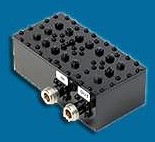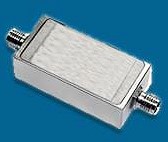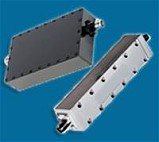Anatech Electronics Newsletter - September 2017 |


Press Release Archives: 2024 | 2023 | 2022 | 2021 |2020 2019 | 2018 | 2017 | 2016 | 2015 2014 | 2013 | 2012 | 2011 | 2010 2009 | 2008 | 2007 | 2006 | 2005 Content is copyright of company represented. Page format, custom text and images are RF Cafe copyright - do not distribute. Anatech Electronics, a manufacturer of RF and microwave filters, has published its September newsletter. In it, Sam Benzacar discusses an ambient electrical noise problem that neither his filter company nor anyone else's filter company can do anything about - signals beginning in the super low frequency (30 Hz - 3 kHz) generated by or as a result of operation from AC line voltages. That includes everything from bedside clocks to smart refrigerators. The problem is growing rapidly. Ironically, just yesterday I posted an article titled "Electronic Pollution .... An Impending Crisis" from a 1973 issue of Popular Electronics magazine that addressed the same phenomenon. As the old saying goes, "The more things change, the more they stay the same." A Word from Sam Benzacar  A New Interference Threat from An Old Nemesis By Sam Benzacar After writing this column for more than four years, I thought I must surely have discussed the most important sources of interference to wireless communications and other RF-centric systems. However, it recently occurred to me that I've almost always focused on one type of wireless system interfering with another, when in fact there is an entirely different perspective that's no less important: the impact of very-low-frequency signals produced by every type of system powered by power-line AC voltage. Electrical interference detectable by a receiver has been with us since the earliest days of radio. "Back in the day" when modulation techniques were analog it was easy to spot it: just listen to an AM radio. But today transmission schemes are digital and your smartphone won't audibly demonstrate its effects until signal-to-noise ratio is so low that it drops a call or data session. The truth is that interference is not only present it is silently degrading receiver performance as it always has. It's also going to get worse. Although it's likely that no one likely track it, the RF power output of base station transmitters has been declining for years. Only paging transmitters deliver truly high RF output power of about 1 kW, and this business is in a steep decline. This means that receivers must be extremely sensitive to detect and process weaker signals produced by today's smaller base stations, which increasingly consist of small cells, the smallest of which have an effective radiated power of only 250 mW. It also means that wireless devices must compensate for this by increasing their output power, if they have this capability, which reduces battery life. IoT networks have a similar problem, if not worse, as in many operating environments such as manufacturing facilities, their tiny wireless-enabled sensors will be near many very "loud" equipment. Even your home automation system isn't safe. Drag that old AM radio out of storage and walk around your house in search of interferers. You won't be disappointed: I placed mine near a cheap charger for 18650 Li-Ion batteries and it wiped out the broadcast from WABC's 50-kW transmitter that's less than 10 miles away. Combine this every digital clock, set-top box, TV set, microwave oven, fluorescent or LED light bulb in the house and the aggregate interference is substantial. Even the latest computers, although better shielded and less noisy than their predecessors produce prodigious amount of noise. I usually end this column by pointing out how RF and microwave filters can solve your problem, but in this case even these venerable solutions usually can't help as the emitters are everywhere. In short, electrical interference is today's unseen, unheard menace whose presence is silently degrading the performance of wireless communications system, and there's not much we can do about it. Bluetooth Vulnerability Lets Hackers Access Phones in 10 Seconds
Apple Watch Integrates LTE
Gigabit LTE Nearly a Reality Download speeds of 750 Mb/s or more require that the smartphone has the necessary chipset to support it and Apple's new iPhone X is one of them, but the company hasn't specifically mentioned Gigabit LTE. This means that only the Motorola Moto Z2 Force and Galaxy S 8 are so enabled, but other phones coming before the end of the year are likely to join them. Other phones, including the iPhone X support data rates up to 600 Mb/s via LTE Advanced so not specifically having Gigabit LTE capability is not likely to be a deal breaker for now. Test Delivers More Than 1 Gb/s Using T-Mobile Network
Check out Our Filter Products
Cavity Band Pass Filters LC Band Pass Filters Cavity Bandstop/Notch Filter About Anatech Electronics Anatech Electronics, Inc. (AEI) specializes in the design and manufacture of standard and custom RF and microwave filters and other passive components and subsystems employed in commercial, industrial, and aerospace and applications. Products are available from an operating frequency range of 10 kHz to 30 GHz and include cavity, ceramic, crystal, LC, and surface acoustic wave (SAW), as well as power combiners/dividers, duplexers and diplexers, directional couplers, terminations, attenuators, circulators, EMI filters, and lightning arrestors. The company's custom products and capabilities are available at www.anatechelectronics.com. Contact: Anatech Electronics, Inc. 70 Outwater Lane Garfield, NJ 07026 (973) 772-4242
Posted September 28, 2017 |
 Bluetooth become the latest wireless technology
to be hacked this month when security company Armis revealed they had discovered eight vulnerabilities
that can let hackers take control of any Bluetooth-enabled device. The attack can be used
to perform multiple functions including remote code execution and man-in-the-middle attacks.
A hacker can identify a device, connect to it via Bluetooth, and begin controlling the screen
and apps. Apple devices running iOS 10 were spared, Microsoft and Google issued patches for
Windows and Android, respectively. As usual, only people with Google phones and tablets got
the patch immediately; everyone else will have to wait, possibly for months.
Bluetooth become the latest wireless technology
to be hacked this month when security company Armis revealed they had discovered eight vulnerabilities
that can let hackers take control of any Bluetooth-enabled device. The attack can be used
to perform multiple functions including remote code execution and man-in-the-middle attacks.
A hacker can identify a device, connect to it via Bluetooth, and begin controlling the screen
and apps. Apple devices running iOS 10 were spared, Microsoft and Google issued patches for
Windows and Android, respectively. As usual, only people with Google phones and tablets got
the patch immediately; everyone else will have to wait, possibly for months. 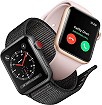 Apple is not the first
company to put LTE capability in a smartwatch, but it's definitely the first company to put
it in a good smartwatch. The Apple Watch 3 let's you run apps, make phone calls, use maps,
and stream any song or radio station on Apple Music, receive notifications, and assorted other
functions, without the need for your phone. The watch's display is even the antenna for LTE
and UMTS. The jury is obviously still out on what this will do to battery life.
Apple is not the first
company to put LTE capability in a smartwatch, but it's definitely the first company to put
it in a good smartwatch. The Apple Watch 3 let's you run apps, make phone calls, use maps,
and stream any song or radio station on Apple Music, receive notifications, and assorted other
functions, without the need for your phone. The watch's display is even the antenna for LTE
and UMTS. The jury is obviously still out on what this will do to battery life.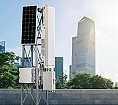 Nokia and Qualcomm have successfully transmitted data
at up to 1.175 Gb/s over T-Mobile US's 4G network. The test was performed using three-carrier
aggregation, a single Nokia 4.9G AirScale base station, and a test device using Qualcomm's
Snapdragon X20 LTE modem that combines 4x4 MIMO and 256QAM. The achievement required the use
of 12 data streams and was just short of the theoretical maximum download speed (1.2 Gb/s)
possible using a Cat. 18 LTE device.
Nokia and Qualcomm have successfully transmitted data
at up to 1.175 Gb/s over T-Mobile US's 4G network. The test was performed using three-carrier
aggregation, a single Nokia 4.9G AirScale base station, and a test device using Qualcomm's
Snapdragon X20 LTE modem that combines 4x4 MIMO and 256QAM. The achievement required the use
of 12 data streams and was just short of the theoretical maximum download speed (1.2 Gb/s)
possible using a Cat. 18 LTE device. 